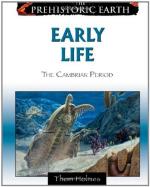|
This section contains 682 words (approx. 3 pages at 300 words per page) |

|
The Cambrian period (570 million years ago) marks an extraordinary shift in the evolution of life. It ushers in the beginning of the Paleozoic Era (the age of ancient life).
Cambrian period and surrounding time periods.
| Era | Period | Epoch | Million Years Before Present |
| Paleozoic | Permian | 286 | |
| Pennsylvanian | 320 | ||
| Missipian | 360 | ||
| Devonian | 408 | ||
| Silurian | 438 | ||
| Ordovician | 505 | ||
| Cambrian | 570 |
In the Precambrian, a three-billion-year period of evolutionary stasis, the dominant life-forms were prokaryotes (tiny one-celled bacteria) and blue-green algae, both of which thrived in the steaming waters and nitrogen-and sulfur-rich air of a geologically turbulent Earth. Prokaryotes are the simplest forms of life, undifferentiated cells with no nucleus that reproduce by fission, the splitting of the parent cell into two. Prokaryotes live off hydrogen, sulfur, and nitrogen and they release free oxygen as a waste product. The prokaryotes' leisurely existence continued for five-sixths of recorded time, during which their massive colonies of cyanobacteria, fossilized as...
|
This section contains 682 words (approx. 3 pages at 300 words per page) |

|


